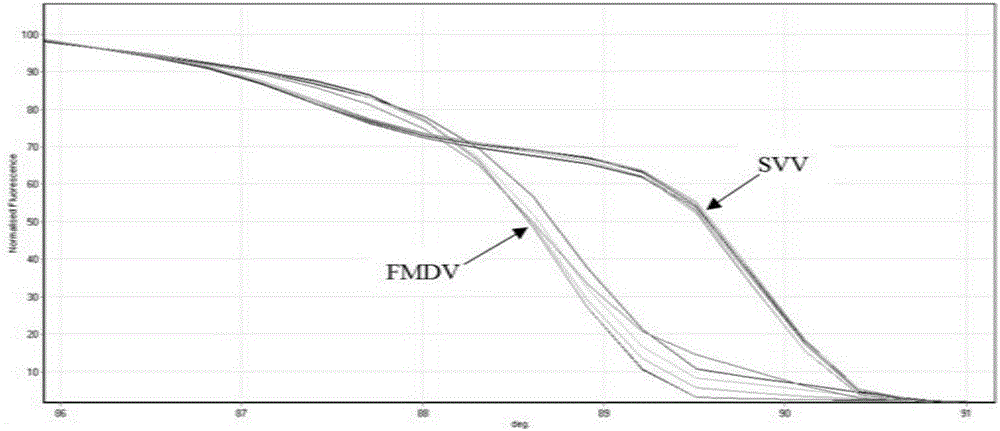HRM detecting primers and method for distinguishing foot-mouth disease virus and Seneca Valley virus
A technology for swine foot-and-mouth disease virus and detection method, applied in the field of biological detection, can solve the problems of timely diagnosis and treatment of unfavorable diseases, cumbersome operation methods, time-consuming and labor-intensive, etc., and achieves the effects of high accuracy, high-throughput analysis, and low cost
- Summary
- Abstract
- Description
- Claims
- Application Information
AI Technical Summary
Problems solved by technology
Method used
Image
Examples
Embodiment 1
[0027] Embodiment 1PCR primer design
[0028] A pair of primers P1 and P2 for amplifying partial gene sequences of porcine foot-and-mouth disease virus and porcine senega valley virus were designed according to the gene sequences of porcine foot-and-mouth disease virus and porcine senega valley virus, and their base sequences are as follows.
[0029] P1: ACTTTTCTGAAAGATGAAAT (SEQ ID NO: 1);
[0030] P2: TTGTCDGCTGGAGTCAT (SEQ ID NO: 2).
Embodiment 2
[0031] The preparation of embodiment 2 standard sample and PCR-HRM analysis thereof
[0032] (1) Extraction of viral RNA:
[0033] The RNA of porcine foot-and-mouth disease virus and porcine senegal virus in the diseased material samples were extracted with Tiangen's automatic nucleic acid extractor. Samples of disease materials can be easily obtained samples such as blister fluid and blister skin without serious harm to the animal body; they can also be tissue samples such as heart and trachea.
[0034] (2) Preparation of plasmid
[0035] The RNAs of porcine foot-and-mouth disease virus and porcine senega valley virus were respectively taken as templates after sequencing, and P1 and P2 were used as primers (0.5 μM) respectively for RT-PCR amplification. The amplification reaction system was:
[0036] Template 1 μL
[0037] 2×1-StepBuffer12.5μL
[0038] PrimeScript1-step Enzyme Mix 0.5 μL
[0039] Primer P11 μL
[0040] Primer P21 μL
[0041] LCgreen dye 1 μL
[0042] ...
Embodiment 3
[0064] Example 3 Clinical Sample PCR-HRM Analysis
[0065] (1) Extract viral RNA from clinical samples: the method is the same as the RNA extraction method in Example 2 above; (2) Use the extracted viral RNA as a template to perform RT-PCR amplification, and the amplification reaction system is:
[0066] Template 1 μL
[0067] 2×1-StepBuffer12.5μL
[0068] PrimeScript1-step Enzyme Mix 0.5 μL
[0069] Primer P11 μL
[0070] Primer P21 μL
[0071] LCgreen dye 1 μL
[0072] wxya 2 O3μL
[0073] The total volume is 20 μL.
[0074] The reaction program of RT-PCR amplification was: (i) 30 min at 50°C; (ii) pre-denaturation at 94°C for 15 min; (iii) denaturation at 94°C for 30 s, annealing at 50°C for 30 s, and extension at 72°C for 45 s; (iii) final denaturation at 72°C. Extend for 10 min, wherein, step (iii) was cycled 35 times; melting curve analysis was performed at a melting rate of 0.3°C / s from 80°C to 93°C.
[0075] HRM analysis was performed on the amplified products...
PUM
 Login to View More
Login to View More Abstract
Description
Claims
Application Information
 Login to View More
Login to View More - R&D
- Intellectual Property
- Life Sciences
- Materials
- Tech Scout
- Unparalleled Data Quality
- Higher Quality Content
- 60% Fewer Hallucinations
Browse by: Latest US Patents, China's latest patents, Technical Efficacy Thesaurus, Application Domain, Technology Topic, Popular Technical Reports.
© 2025 PatSnap. All rights reserved.Legal|Privacy policy|Modern Slavery Act Transparency Statement|Sitemap|About US| Contact US: help@patsnap.com



